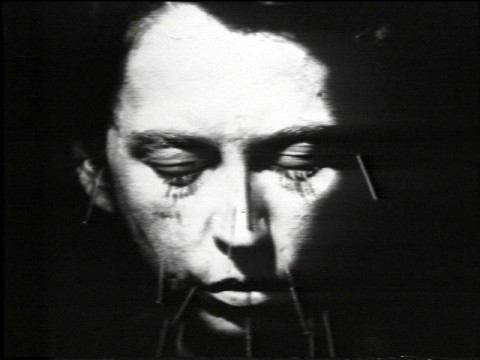The art of Linda Mary Montano focuses on patience and empathy, qualities that are essential for executing the intense endurance-based performances for which she is best known. The daughter of two orchestral musicians, Montano was raised in a strict Irish and Italian Catholic household that was also filled with art and creativity. Inspired by her faith, she wanted to devote her life to helping others and joined the Maryknoll Sisters order after her first year at College of New Rochelle. After two years in training, however, Montano had developed a severe case of anorexia and weighed only eighty pounds. Convinced art was the best remedy for her condition, she returned to her former school and graduated with a degree in sculpture. Despite or due to the difficulties of this period, Montano came to believe that “life is art/art is life.”
She went on to earn an MA in sculpture from Villa Schifanoia in Italy, and then an MFA from the University of Wisconsin. However, by 1971, she was devoting her practice to performance art. After moving to San Francisco with her husband, photographer Mitchell Payne, in 1970, Montano conducted performances for which she was physically tied to other artists ( _Handcuff_ [1973] with Tom Marioni) or was blindfolded for three days ( _Three Day Blindfold_ [1974]). And like many first-wave feminist performance artists of the 1970s, Montano enjoyed assuming various personas. In _Learning to Talk_ (1978) she costumed herself as various characters, including a cowgirl and a karate instructor.
During the 1980s, Montano adopted a more intense and controlled approach to her art. _Art/Life: One Year Performance_ (1983–84) was an extreme endurance work with Taiwanese performance artist Tehching Hsieh, wherein the two artists spent a year tied together with an eight-foot rope. In 1984 Montano began _Seven Years of Living Art, 1984–91_, the first of two cycles to engage the seven energy centers, or chakras, and their corresponding colors, sounds, glands, and psychic states. Each year in the series was dedicated to a chakra, and Montano wore only clothing of the color associated with that chakra—red, orange, yellow, green, blue, purple, or white. She spent four hours a day in a correspondingly colored room, three hours listening to one tone, and each year she spoke in a different accent. _Another Seven Years of Living Art, 1991–98_ reversed and repeated the experiences of the previous seven years. At the same time, from 1984 to 1991, Montano conducted monthly tarot counseling sessions entitled _Art/Life Counseling_ in the storefront window space of the New Museum in New York.
In addition to these activities, Montano lived in a Zen Monastery and studied at the Ananda Ashram for thirty years with her spiritual guide, Dr. Ramamurti Mishra. She also established The Art/life Institute in Kingston, New York. In 1996 Montano returned to Catholicism; however, aware of the possible contradictions between her art and religion, in a letter to Pope John Paul II, Montano wrote “Catholic Performance Artist. The title is almost a contestable oxymoron. How can they both co-exist…the vocation to be a performance artist and loyalty to the Roman Catholic Church? This is mystery.”
As a Catholic Performance Artist, from 1998 to 2005, Montano “performed” _Dad Art_, which involved taking care of her dying father. For her, “this event was the culmination of [her] entire practice as an artist.” Thereafter, she has taken prayer requests to Catholic pilgrimage sites and held three-hour silent retreats in Catholic churches. Now in her seventies, Montano continues to create art from her life. In fact, she says, “Right now my focus is on presenting my aging body as a work of art: my wrinkles, my hair.”
Montano’s seminal work, _Mitchell’s Death_ (1977), prefigures her daring, unflinching works of the 1980s as well as the meditative events of her more recent years. In this black-and-white video, she mourns the sudden death of her husband from a gun accident by recounting every detail of her experience. In a ritualistic manner, she tells her story in a monotone voice, reminiscent of Buddhist chanting, while her face is pierced with acupuncture needles. Montano’s narration is slightly out of sync with the grainy image of her visage that fills the frame. The combined effect of these formal aspects intensifies the uncanniness of the scene for the viewer. However, Montano created the work to help herself cope with and heal from the loss of her husband. _Mitchell’s Death_ thus powerfully exemplifies the patience and empathy of Montano’s art as life. _—Kanitra Fletcher_

